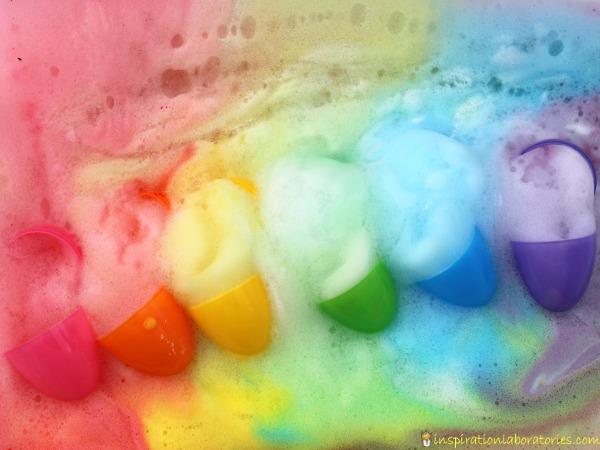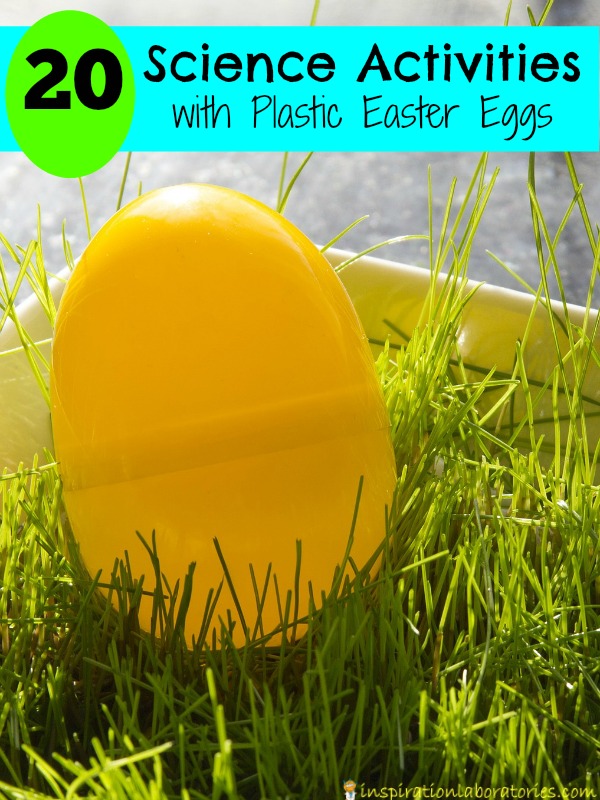Rainbow Foam Eggs
Want to learn how to turn a classic science experiment into a colorful sensory experience? Grab those plastic eggs you have ready for Easter and have fun experimenting with our Rainbow Foam Eggs. What happens when you change the amounts of hydrogen peroxide or yeast?

Rainbow Foam Eggs
Our rainbow foam eggs combine yeast, soap, and hydrogen peroxide to produce an awesome soap foam. Food coloring or liquid water colors makes the foam colorful. Place the mixture in the eggs and watch them explode.
What You’ll Need:
- safety goggles
- colorful plastic eggs (the large size works better)
- tape
- large deep container, sink, or bathtub (or you can go outside)
- dry active yeast (from the baking aisle)
- warm water (to activate the yeast)
- dish soap like Dawn (do not use an antibacterial soap)
- liquid watercolors or food coloring
- hydrogen peroxide (3% hydrogen peroxide is what is normally found in your first aid supplies. It works great for this activity.)
- Cover the holes in the plastic eggs with tape.
- Mix 1 teaspoon of the dry active yeast in 3-4 tablespoons of warm water. (Using water that’s too hot will kill the yeast.) Now the yeast is active and ready to work.

- Add hydrogen peroxide., a squirt of dish soap, and a few drops of liquid watercolors or food coloring (I used a tiny amount of Wilton’s gel food coloring) to a small bowl.
- Place your plastic eggs in a large container or in the sink or bathtub.
- Add a teaspoon of the yeast mixture to the small half of each plastic egg.

- Fill the large half of your plastic egg about 1/2 to 3/4 of the way with the hydrogen peroxide mixture.
- Are your safety goggles on? Quickly put together the halves of the plastic egg.
- Repeat with each color of egg.

As you are assembling the later eggs, the foam will begin to escape and break open the first eggs.

If the eggs break too quickly, try putting less hydrogen peroxide in your egg. Less liquid means more time for the foam to build up before the eggs break. If your eggs don’t break, then they are probably leaking too much. Check that the tape is covering the holes well enough. It’s still cool if the the foam just escapes out the holes. You just won’t get an “explosion.”
As you let the eggs sit, the foam will continue to expand. You can refill the eggs and do this all over again.

What happens if you change the amounts of hydrogen peroxide or yeast used? Design an experiment to find out!
The Science Behind It
Hydrogen peroxide is not very stable and readily breaks down into water and oxygen. The yeast catalyzes this reaction. This means the yeast speeds up the break down of the hydrogen peroxide. Because we are using 3% hydrogen peroxide, the resulting foam is just soap and water so it’s safe to touch. This is an exothermic reaction which means it produces heat. The egg and foam will be a little warm.
More Science with Easter Eggs
Check out these 20 Science Activities with Plastic Easter Eggs
Subscribe to the Inspiration Laboratories newsletter. Each issue has exclusive hands-on science explorations for children, a recap of our latest activities, and special resources selected just for you!
This post was originally published on February 23, 2016.


Leave a Reply